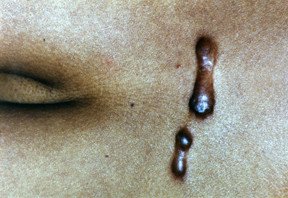Keloids
Medically reviewed by Drugs.com. Last updated on Dec 4, 2023.
What are Keloids?

Keloids are raised overgrowths of scar tissue that occur at the site of a skin injury. They occur where trauma, surgery, blisters, vaccinations, acne or body piercing have injured the skin. Less commonly, keloids may form in places where the skin has not had a visible injury. Keloids differ from normal mature scars in composition and size. Some people are prone to keloid formation and may develop them in several places.
|
|
Keloids are more common in African-Americans. They are seen most commonly on the shoulders, upper back and chest, but they can occur anywhere. When a keloid is associated with a skin incision or injury, the keloid scar tissue continues to grow for a time after the original wound has closed, becoming larger and more visible until it reaches a final size. They generally occur between 10 and 30 years of age and affect both sexes equally, although they may be more common among young women with pierced ears. Keloids may form over the breastbone in people who have had open heart surgery.
Symptoms
Keloids usually appear in areas of previous trauma but may extend beyond the injured area. They are shiny, smooth and rounded skin elevations that may be pink, purple, or brown. They can be doughy or firm and rubbery to the touch, and they often feel itchy, tender or uncomfortable. They may be unsightly. A large keloid in the skin over a joint may interfere with joint function.
Diagnosis
A doctor diagnoses a keloid on the basis of its appearance and a history of tissue injury, such as surgery, acne or body piercing. In rare cases, the doctor may remove a small piece of the skin to examine under a microscope. This is called a biopsy.
Expected duration
Keloids may continue to grow slowly for weeks, months or years. They eventually stop growing but do not disappear on their own. Once a keloid develops, it is permanent unless removed or treated successfully. It is common for keloids that have been removed or treated to return.
Prevention
People who are prone to keloids should avoid cosmetic surgery. When surgery is necessary in such people, doctors can take special precautions to minimize the formation of keloids at the site of the incision. Examples of techniques that might be used to minimize keloid formation include covering the healing wound with hypoallergenic paper tape for several weeks after surgery, covering the wound with small sheets made of a silicone gel after the surgery, or using a topical corticosteroid at the site of the surgical wound at the beginning of the healing period.
Treatment
There is no single treatment for keloids, and most treatments do not give completely satisfying results. Two or more treatments may be combined. If you decide to pursue treatment for a keloid scar, you will have the best results if you start treatment soon after the keloid appears. Available treatments include:
- Removal with conventional surgery — This unreliable technique requires great care, and keloids that return after being removed may be larger than the original. Keloids return in more than 45% of people when they are removed surgically. Keloids are less likely to return if surgical removal is combined with other treatments.
- Dressings — Moist wound coverings made of silicone gel sheets have been shown in studies to sometimes reduce the size of keloids over time. This treatment is safe and painless.
- Corticosteroid injections — Injections into keloids with triamcinolone acetonide or another corticosteroid medicine typically are repeated at intervals of four to six weeks. This treatment can often reduce keloid size and irritation, but injections are uncomfortable.
- Compression — This involves using a bandage or tape to apply continuous pressure 24 hours a day for a period of six to 12 months. Such compression can cause a keloid to become smaller. For keloids that form at the site of an ear piercing, a clip known as a "Zimmer splint" usually reduces keloid size by at least 50% after one year of compression. Zimmer splints that resemble earrings are available.
- Laser therapy — This is an alternative to conventional surgery for keloid removal. There is no good evidence that keloids are less likely to return after laser therapy than after regular surgery.
- Fluorouracil injections — Injections into the keloids with the combination of the chemotherapy drug fluorouracil and triamcinolone have been used when other measures have not been successful.
Treatment options
The following list of medications are related to or used in the treatment of this condition.
When to call a professional
Keloids are primarily a cosmetic concern. If a scar becomes enlarged, itchy, uncomfortable, interferes with the movement of a joint, or creates an unacceptable cosmetic effect, discuss treatment options with your doctor.
Prognosis
Keloids are harmless, cosmetic problems that do not become cancerous (malignant). Once a keloid stops growing, it usually remains stable unless the area is injured again.
Additional info
American Academy of Dermatology
https://www.aad.org/
Further information
Always consult your healthcare provider to ensure the information displayed on this page applies to your personal circumstances.

